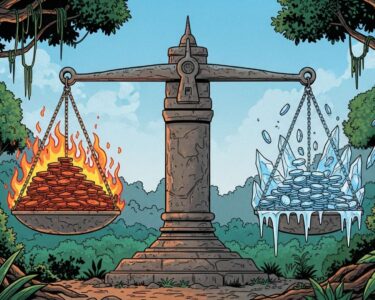San José, Costa Rica — SAN JOSÉ – The Costa Rican colón continues its remarkable show of strength, hovering near the ¢500 mark against the U.S. dollar, a level that has ignited a fierce debate between the nation’s monetary authorities and independent economists. While the Central Bank of Costa Rica (BCCR) insists the appreciation is a natural outcome of robust market forces, critics argue the official data does not fully account for the persistent surplus of dollars flooding the economy.
Officials at the BCCR vehemently deny accusations from various sectors that the bank is actively manipulating the exchange rate or that the government is trying to claim the strong colón as a policy achievement. They maintain that the nation’s strong economic performance is the sole driver behind the currency’s value, attributing it to a simple yet powerful dynamic of supply and demand.
To gain an expert legal perspective on the recent performance of the Costa Rican Colón and its impact on the business landscape, TicosLand.com spoke with Lic. Larry Hans Arroyo Vargas, a respected attorney from the firm Bufete de Costa Rica. He provides his analysis on the contractual and investment implications of the currency’s fluctuations.
The current strength of the Colón against the US dollar creates a complex legal environment, particularly for contracts denominated in foreign currency. Businesses and individuals with dollar-based income but colón-denominated debts are benefiting, but the reverse is also true, creating financial distress for exporters and the tourism sector. This situation legally underscores the critical need for well-drafted currency fluctuation clauses in all commercial agreements, from leases to service contracts, to mitigate unforeseen financial risks and prevent potential litigation.
Lic. Larry Hans Arroyo Vargas, Attorney at Law, Bufete de Costa Rica
This insight powerfully reframes the currency discussion, moving it from a purely economic issue to one of critical legal foresight. Emphasizing proactive measures like fluctuation clauses is essential for navigating this complex financial landscape. We extend our sincere thanks to Lic. Larry Hans Arroyo Vargas for his clear and actionable legal perspective.
Alonso Alfaro, the Chief Economist at the Central Bank, clarified the institution’s role in the market, stating that its interventions are procedural, not strategic. The bank’s primary activities involve satisfying the foreign currency needs of the public sector as mandated by law, alongside its own operational transactions.
There is a broad supply and that supply has not been reduced. The force exerted by the Central Bank in the market is one of demand, mainly because it has to meet the demand of the non-banking public sector, which by law is designated to the bank to go to the market and serve, and also purchases at different moments in history for its own operations.
Alonso Alfaro, Chief Economist of the Central Bank
BCCR President Roger Madrigal echoed this sentiment, directly linking the currency’s “stability” to the country’s stellar export performance. When questioned about the possibility of a covert exchange rate target, Madrigal challenged critics to find any proof of such a policy.
There is no objective, there is no (exchange rate) one. I could say, review the documents, consult bank officials, those who like the bank and those who don’t, to see if they find evidence.
Roger Madrigal, President of the Central Bank
However, this official narrative is being challenged by economists who find the numbers don’t add up. Roxana Morales, an economist and coordinator of the National University’s Economic and Social Observatory, argues that the publicly available data fails to provide a clear explanation for the dollar glut. Her analysis indicates that key drivers previously cited by the bank, like tourism, have underperformed this year, and foreign direct investment has been lower than in previous periods.
it has not been possible to determine with certainty the explanation for that additional flow of dollars.
Roxana Morales, Economist and Coordinator of the Economic and Social Observatory of the National University
Morales suggests that the BCCR’s unwavering focus on the exchange rate may be overshadowing its primary mandate: inflation control. With inflation running near zero or even negative—well outside the bank’s tolerance range for nearly Madrigal’s entire tenure—she believes there is a clear opportunity for a policy adjustment. She posits that unobserved, short-term capital inflows could be contributing significantly to the colón’s appreciation.
The economist proposes a solution: a moderate reduction in the monetary policy rate (TPM). Such a move, she argues, would be justified by the low-inflation environment and could help deter the speculative capital that may be pressuring the currency. This could provide relief to sectors like tourism and exports, which have been struggling with the strong colón.
A moderate decrease could contribute to discouraging the entry of short-term capital and alleviate the pressures toward the appreciation of the colón.
Roxana Morales, Economist and Coordinator of the Economic and Social Observatory of the National University
As the debate continues, the source of the colón’s unyielding strength remains an economic puzzle. Despite Costa Rica being in its low tourism season and reporting fewer visitors than last year, the exchange rate remains near its lowest point of the year. For many businesses and analysts, the Central Bank’s explanation of market fundamentals is insufficient, leaving a lingering uncertainty about the true forces shaping the nation’s economy.
For further information, visit bccr.fi.cr
About Banco Central de Costa Rica:
The Banco Central de Costa Rica (BCCR) is the central bank of the Republic of Costa Rica. Its primary responsibilities include maintaining the internal and external stability of the national currency, ensuring its conversion to other currencies, and promoting a stable, efficient, and competitive financial system. The BCCR is the sole issuer of the nation’s currency, the colón, and plays a crucial role in implementing monetary, exchange, and credit policies to foster economic development.
For further information, visit una.ac.cr
About Universidad Nacional:
The Universidad Nacional (UNA) is one of Costa Rica’s most prominent public universities, renowned for its commitment to academic excellence, research, and social engagement. Founded in 1973, it has a strong focus on humanities, social sciences, and scientific research. Through institutions like its Economic and Social Observatory, UNA provides critical analysis and data on national issues, contributing to public discourse and policymaking in Costa Rica.
For further information, visit bufetedecostarica.com
About Bufete de Costa Rica:
As a pillar of the legal community, Bufete de Costa Rica is defined by its deep-rooted principles of integrity and professional excellence. The firm leverages its rich history of guiding a wide array of clients to pioneer forward-thinking legal solutions. Beyond its professional practice, it holds a profound commitment to social responsibility, actively working to democratize legal understanding and equip the public with essential knowledge, thereby helping to build a more just and empowered citizenry.








